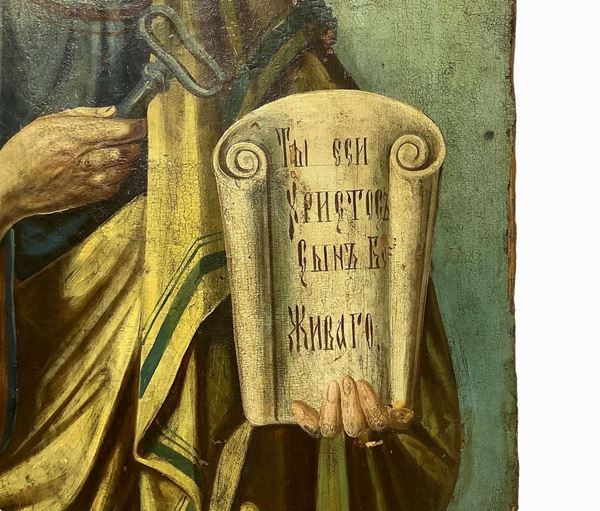182
Saint Peter, XV / XVI century
Tempera on table
H 128x62x3.8 cm
The saint - identified as St. Peter's for the presence of his attribute, the key, held in his right hand and for the inscription at the top which reads: CB. APOS. PÉTRZ, whose translation means SAINT APOSTLE PETER-is depicted standing, with his eyes wide and fixed, thus emphasizing his spiritual nature. In his left hand, however, he holds a white scroll containing a formula, which translated reveals: YOU ARE THE SON OF THE LIVING GOD.
It is clear that we are not dealing with a table that traditionally depicts a saint whose features would refer to the sphere of Byzantine influence, rather we observe the agile hand of a painter, linked to strongly Latin stylistic features. Some elements - both graphic and stylistic - bring our table back to that production area that can be geographically placed in a well-circumscribed area, in which ecclesiastical Slovenian, a language developed from the 9th onwards, was in use in the liturgical context. century thanks to the brothers Methodius and Cyril who used it to be able to translate the Holy Scriptures from the Greek language, therefore, an area that embraces Serbia, Croatia, Bohemia, eastern Poland as well as the Russian principalities.
The painting is strongly linked to all those more innovative aspects of the Italian area of the 15th century, such as the hint to the perspective depth, revealed by some timid lines of flight that recall the presence of a pavement on which the saint stands. , and, in the background, instead, it is possible to distinguish some clouds, connoting an external environment. Spatiality opens the scene, becoming the unifying element of our table which was certainly part of a larger polyptych, whose pieces were originally connected and united. The ductus of our painter also highlights his Latin influence in the rendering of some details, such as the use of small strokes of the brush to make the softness of the beard, in the use of chiaroscuro that highlights the voluminous drapery of the apostle by defining the shadows produced by a light coming from the left.
An artist really attentive to the real thing and this can be seen from the well-built veins in the left hand and a small wrinkle that furrows the forehead of the saint.
One could think of an area closer to Italy, such as the Dalmatian peninsula in connection with the Venetian lagoon. An artist, therefore, who necessarily had to adapt and conform to the language of icons - such as the fixity of his gaze - but at the same time giving his figures all the updates of his time.
Chipped paint at the bottom, along the sides.












